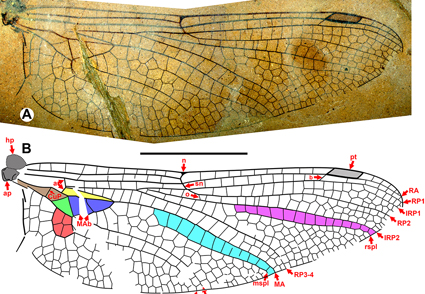Abstract
We describe the darner dragonfly Kishenehna prima n. gen. and sp. (Odonata, Aeshnidae, Gomphaeschninae) based on a well-preserved, nearly complete female hind wing from the Lutetian Coal Creek Member of the Kishenehn Formation, northwestern Montana, USA. Kishenehna is morphologically close to the late Paleocene genus Alloaeschna Wighton & Wilson of Alberta, Canada. This is the first dragonfly (Anisoptera) described from the Kishenehn Formation and the first from the Lutetian of the Western Hemisphere.
References
Archibald, S.B. & Cannings, R.A. (2019) Fossil dragonflies (Odonata: Anisoptera) from the early Eocene Okanagan Highlands, western North America. The Canadian Entomologist, 151, 783–816. https://doi.org/10.4039/tce.2019.61
Bechly, G., Nel, A., Martinez-Delclòs, X., Jarzembowski, E.A., Coram, R., Martill, D. et al. (2001) A revision and phylogenetic study of Mesozoic Aeshnoptera, with description of numerous new taxa (Insecta: Odonata: Anisoptera). Neue Paläontologilsche Abhandlungen, 4, 1–219, 48 pls.
Constenius, K.N. (1996) Late Paleogene extensional collapse of the Cordilleran foreland fold and thrust belt. Geological Society of America Bulletin, 108, 20–39. https://doi.org/10.1130/0016-7606(1996)108<0020:LPECOT>2.3.CO;2
Dijkstra, K.-D.B., Bechly, G., Bybee, S.M., Dow, R.A., Dumont, H.J., Fleck, G., Garrison, R.W., Hämäläinen, M., Kalkman, V.J., Karube, H., May, M.L., Orr, A.G., Paulson, D.R., Rehn, A.C., Theischinger, G., Trueman, J.W.H., Van Tol, J., von Ellenrieder, N. & Ware, J (2013) The classification and diversity of dragonflies and damselflies (Odonata). In: Zhang, Z.-Q. (Ed.), Animal biodiversity: an outline of higher-level classification and survey of taxonomic richness. Zootaxa, 3703 (1), pp. 36–45. https://doi.org/10.11646/zootaxa.3703.1.9
Garrouste, R. & Nel, A. (2019) Alaskan Palaeogene insects: a challenge for a better knowledge of the Beringian ‘route’ (Odonata: Aeshnidae, Dysagrionidae). Journal of Systematic Palaeontology, 17, 1939–1946. https://doi.org/10.1080/14772019.2019.1572235
Greenwalt, D.E. & Bechly, G. (2014) A re-description of the fossil damselfly Eolestes syntheticus Cockerell, 1940 (Odonata: Zygoptera: Eolestidae n. fam.) with description of new taxa from the Eocene of North America. Zootaxa, 3887 (2), 138–156. https://doi.org/10.11646/zootaxa.3887.2.2
Greenwalt, D.E., Bickel, D.J., Kerr, P.H., Curler, G.R., Brown, B.V., de Jong, H., Fitzgerald, S.J., Dikow, T., Tkoč, M., Kehlmaier, C. & Amorim, D.S. (2019) Diptera of the middle Eocene Kishenehn Formation. I. Documentation of diversity at the family level. Palaeontologia Electronica, 22.2.50A, 1–56. https://doi.org/10.26879/891
Grimaldi, D. & Engel, M.S. (2005) Evolution of the Insects. Cambridge University Press, New York, 755 pp.
Hoffman, G.L. & Stockey, R.A. (1999) Geological setting and paleobotany of the Joffre Bridge Roadcut fossil locality (Late Paleocene), Red Deer Valley, Alberta. Canadian Journal of Earth Sciences, 36, 2073–2084. https://doi.org/10.1139/e99-095
Jarzembowski, E.A. & Nel, A. (1996) A new genus and species of hawker dragonfly (Aeshnidae) from the Lower Cretaceous of southern England. Cretaceous Research, 17, 97–101. https://doi.org/10.1006/cres.1996.0007
Lenz, O.K., Wilde, V., Mertz, D.F. & Riegel, W. (2015) New palynology‑based astronomical and revised 40Ar/39Ar ages for the Eocene maar lake of Messel (Germany). International Journal of Earth Sciences, Geologische Rundschau, 104, 873–889. https://doi.org/10.1007/s00531-014-1126-2
Meyer, W.H. (2003) The Fossils of Florissant. Smithsonian Books, Washington, 258 pp.
Riek, E.F. & Kukalová-Peck, J. (1984) A new interpretation of dragonfly wing venation based upon Early Upper Carboniferous fossils from Argentina (Insecta: Odonatoidea) and basic character states in pterygote wings. Canadian Journal of Zoology, 62, 1150–1166.
von Ellenrieder, N. (2002) A phylogenetic analysis of the extant Aeshnidae (Odonata: Anisoptera). Systematic Entomology, 27, 437–467. https://doi.org/10.1046/j.1365-3113.2002.00190.x
Wappler, T. (2003) Die Insekten aus dem Mittel-Eozän des Eckfelder Maares, Vulkaneifel. Mainzer Naturwissenschaftliches Archiv Beiheft, 27, 1–234.
Wighton, D.C. (1987) Gomphaeschna obliqua spec. nov., a new species of Gomphaeschninae from the Lower Cretaceous of northeastern Brazil (Anisoptera: Aeshnidae). Odonatologica, 16, 311–314.
Wighton, D.C. & Wilson, M.V.H. (1986) The Gomphaeschninae (Odonata: Aeshnidae): new fossil genus, reconstructed phylogeny, and geographical history. Systematic Entomology, 11, 505–522. https://doi.org/10.1111/j.1365-3113.1986.tb00539.x
Zheng, D., Jarzembowski, E.A., Su-Chin Chang, S.-C. & Wang, B. (2016) A new true dragonfly (Odonata, Anisoptera, Gomphaeschnaoidini) from mid-Cretaceous Burmese amber. Proceedings of the Geologists’ Association, 127, 629–632. https://doi.org/10.1016/j.pgeola.2016.07.006
Zheng, D.R., Nel, A. & Wang, B. (2019) New gomphaeschnid dragonflies (Odonata: Anisoptera: Aeshnoptera) from mid-Cretaceous Burmese amber. Cretaceous Research, 100, 138–144. https://doi.org/10.1016/j.cretres.2019.03.027


